Denon AVR-X4700H Reviewed at $1,999.00
Product Name: Denon AVR-X4700H
Product Description: 9.2 CH 8K AV Receiver
-
Design - 9.1/10
9.1/10
-
Audio Quality - 9.4/10
9.4/10
-
Inputs / Ports - 9.3/10
9.3/10
-
OS, Apps and Features - 8.8/10
8.8/10
-
Price / Quality - 9.3/10
9.3/10
Summary
Reviewed at $1,999.00
Pros
- Great performance
- Dolby Atmos, DTS:X, IMAX Enhanced and Auro-3D
- Build quality up to Denon standards
- Huge list of features
Cons
- HDMI 2.1 has problems with 4K@120Hz
- Only one HDMI 2.1
- Audyssey MultiEQ editing app has a charging fee
- No backlight on remote
Cheapest Places to Buy :
*We are a reader-supported website. When you buy through links on our site, we may earn a small affiliate commission at no extra cost to you. Home Media Entertainment does not accept money for reviews.*
We have been used to see yearly releases from AV receivers manufacturers for some time now but it seems that this is about to change as many factors like the global pandemic, chips shortages and a slightly problematic 2020 release lineup with the infamous HDMI 2.1 bug has led some of them to skip releasing an entire new lineup this year. One of them is Denon and with the exception of a small upgrade in a couple of the higher tier units the rest of the lineup remains the same from last year. So this gives us the chance, in our Denon AVR-X4700H review, to look upon another mid to higher-tier release and if it is still a worthy consideration.
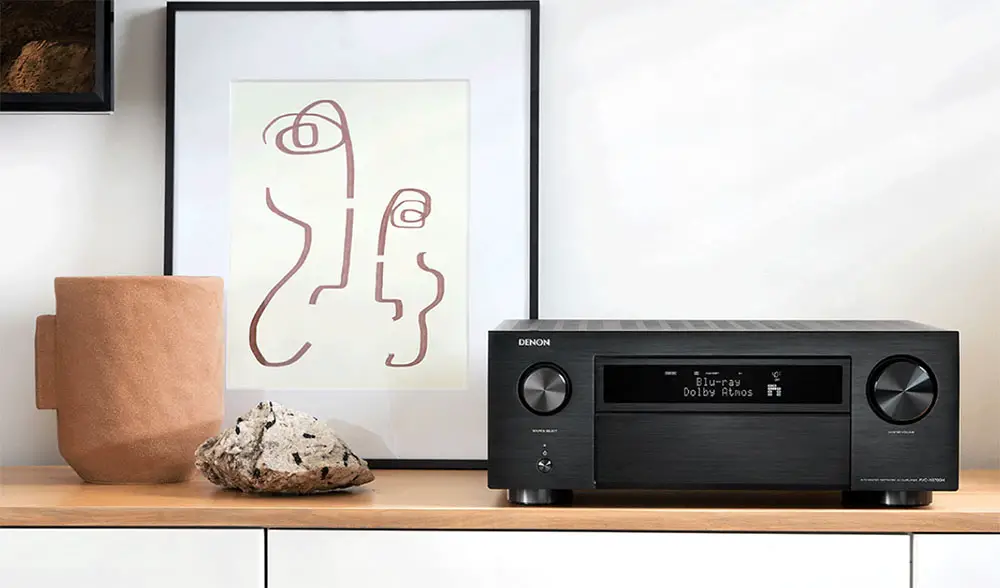
2020 was a somewhat major year for AV receiver manufacturers as they brought to the market units with 8K and HDMI 2.1 support. But it was not smooth sailing as the HDMI 2.1 bug that was discovered soon after created major headaches and left many consumers wondering if it was a worthy purchase. The new HDMI 2.1 support brought with it new tasty features like 8K resolution pass-through, 4K@120fps, HDR10+, ALLM, VRR, QMS and QFT. And thus would allow all gamers a better gaming experience…or that was the plan anyway. But we will talk in detail about this HDMI 2.1 glitch and how it may affect you shortly.
As for the AVR-X4700H specifically, the receiver comes with 9.2 channels of amplification with a total of 125 watts of power. The unit supports Dolby Atmos, DTS:X, Auro-3D and IMAX Enhanced along with the usual virtual and up-mixing tech like Dolby Surround, DTS Neural:X, Dolby Atmos Height Virtualization and DTS Virtual:X, uses the Audyssey MultEQ XT32 auto calibration system while High Resolution Audio, HEOS technology, AirPlay 2, voice control, custom integration, bi-amp capabilities, multi-room zones, Bluetooth Audio Transmission, Pre-Amplifier Mode and HDMI upscaling are some of the extras you will also get.
Recently we had reviewed the AVR-X3700H which was another solid performer from Denon so does the X4700H manages to take things one step further? Let’s find out…
Design
With these yearly releases you shouldn’t have a lot of expectations in terms of their design and general layout as manufacturers tend to use the same shells over and over from previous years. And the 2020 AVR-X4700H is no different as it is exactly the same as the AVR-X4500H which is basically the unit it replaces with only some minor changes.
The X4700H has exactly the same size of 17.1″ x 15.3″ x 9.3″ (434 mm x 389 mm x 236 mm) while you can lower the height, by turning the dual antennas in a horizontal position, to a more manageable 6.6″ (167 mm). The unit weights 30.2 lbs (13.7 kg) making it fairly bulky and heavy and is the kind of receiver that needs ample of space when setting it up. Alternatively some short of cooling solution would be preferable.
At the front face we get the usual large central display with two big knobs on each side for volume and input selection. Under the left knob we get a single power button while everything else is hidden behind a flip-down door. The buttons hidden under it are exactly the same as before so no real surprises here.
The buttons we do get are used for zones control, navigation buttons as well as quick selection buttons. We also get a HDMI input, a USB port, the calibration microphone port and the usual headphones jack. Previously the AVR-X4500H was the first to abandon the front analog inputs and as the AVR-X4700H seems to follow the same route it is clear that Denon is slowly phasing out these outdated ports.

But the outer shell is not the only part where we find similarities compared to previous years as most of the internal components seem to be more of the same. The receiver features discrete high-current amplifiers on all channels with low-impedance drive capability while it’s AKM AK4458 32-bit D/A converters allow for high resolution audio decoding while providing low distortion and the widest possible dynamic range. The AVR-X4700H also comes with two Griffin Lite dual core SHARC DSPs (Digital Sound Processors) chips for decoding and sound processing.
One small note to make here as it seems around Spring Denon made a change in the DACs they use in some of their AV receivers, the AVR-X4700H included, most probably because they had trouble with AKM DAC supplies. What they currently use is unknown but this is a fact that seems to have gone unnoticed by many and is surely an interesting one although we believe most, if not all, will understand little to no difference from this change.
And since the design of the main unit is similar the remote stayed the same also which is something we cannot say we are thrilled about. The remote of the X4700H (code named RC-1240) is entirely the same as the one we saw in the X4500H and has the same brushed metal finish look on top while it comes fully packed with control buttons. The only difference here is that the AUX2 button has changed into an 8K one. The buttons are fairly good organized and separated into groups but their size is a bit small for our liking while they are fairly close to each other making it a bit harder to avoid pushing the wrong one.

The missing backlight is also not helping either as with so many buttons pressing the wrong one in the dark will certainly add more frustration. It’s a real shame not to have a backlit remote when you consider the amount of money you have to pay for such a unit.
The AVR-X4700H doesn’t have any surprises to be honest. We get the same design, same remote and same overall quality that Denon is offering for the last few years. If you have previous experience from this category of AV receivers then you know what to expect.
Audio Quality
The receiver supports the usual Dolby Atmos and DTS:X object oriented audio tracks but also we find Auro-3D and IMAX Enhanced support. The last two are not so usual and you are not going to find much content for them but it is always good to have more which adds more value. Along with these we get support for up-mixing and virtual technology features in order to cover all needs and specific room configurations.
When it comes to up-mixing tech we find the usual Dolby Surround and DTS Neural:X. What these up-mixing tech are doing is to up-convert stereo and legacy mixes in order to make use of all the speakers you have in your setup. As for virtual tech the Dolby Atmos Height Virtualization and DTS Virtual:X are capable of creating sounds that originate from virtual created speakers around your room where there are no physical speakers present.

This virtual tech obviously is not as good and accurate as having real physical speakers and are very much room dependent. Also the sound many times can be heard very over-processed something we were never very fond of.
The X4700H comes with 9 channels of built-in amplification and each channel can output 125 watts of power (8 ohm, 20 Hz – 20 kHz, 0.08% 2ch drive) but keep in mind that this is only for 2 channels meaning that when all 9 channels are active this number goes down considerably. You have the ability to go all the way to 11 channels but for that you will need an external amp to drive the last two channels.
With the built-in amplifiers you can go all the way for a 5.2.4 channels audio setup with four dedicated overhead speakers for maximum immersion. For our test we went for a 5.1.4 setup using a single subwoofer and 4 height speakers placed at the front and back of our viewing area.
For our testing we used the 4K UHD version of the recently released Zack Snyder’s Justice League which comes with a totally flooring Dolby Atmos mix. Snyder’s edition has practically everything you would expect from such kind of a film and if the original theatrical cut was good, Snyder’s version surpasses it in every conceivable way.
The X4700H is right at home here as it had no trouble no matter what scene we decided to play. Either it was mostly dialogue driven or full on action the Denon handled everything masterfully. The front soundstage had great authority and punch with the front channels displaying excellent separation between them. Dialogue was firmly kept at the center and there was no overlapping with the rest of the sound effects. Depth was good and transparency was excellent filling the space between us and out TV with plenty of acoustic information.
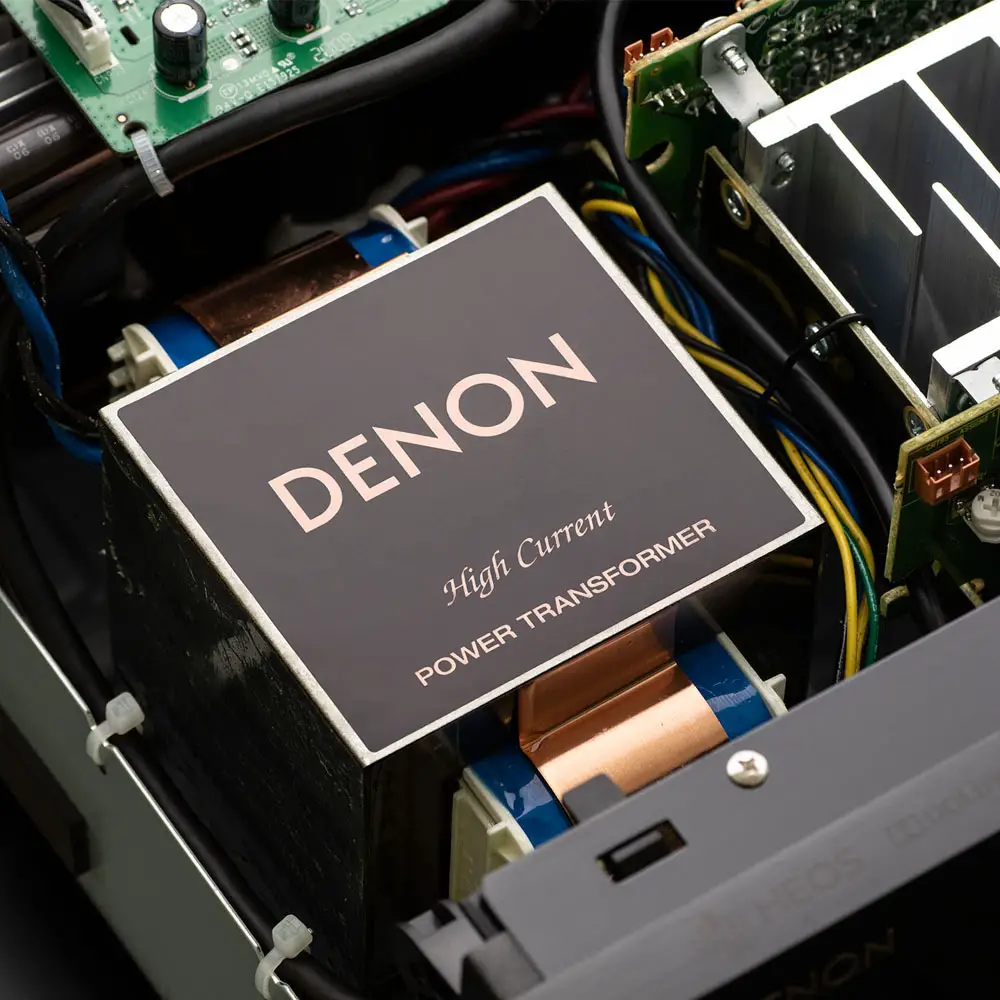
Equally good was the surround acoustics. With the Parademons flying all around panning effects were very intense and precise while various effects like projectiles crossed the various channels without any delay or loss of information. During the ancient battle the surround channels provided the necessary magnitude to the scene with nice extension both in the sides and behind us.
Equally impressive were the Atmos effects and while these were not so much to the face as the rest of the channels they did provide a very lively upper layer that considerably added to the immersion bubble around us. And with four height channels there was good distinction between the front height and rear height effects making the panning sounds even more detailed.
Bass activity was also extraordinary with the initial showdown of Steppenwolf and the Amazons giving us a very good idea of what would follow in the rest of the film. Explosions, debris, gunfire and in general low end activity was spot on and very alive and kicking.
In terms of maximum volume the Denon had plenty of juice and to be honest we didn’t max it out in our test room. We would say that for any small or medium sized room it will be enough but there are many factors that can really determine that.
We couldn’t resist the urge and try some Lord of the Rings goodness so we popped our Return of the King disc in our Panasonic player and skipped forward to the siege of Minas Tirith. What can be said about such an amazing scene? The Denon did its best to portray the large scale battle and to our satisfaction it managed to do so with great mastery. Dynamics were great, soundstage expansion was impressive while surround and Atmos effects added to the immersion tenfold.
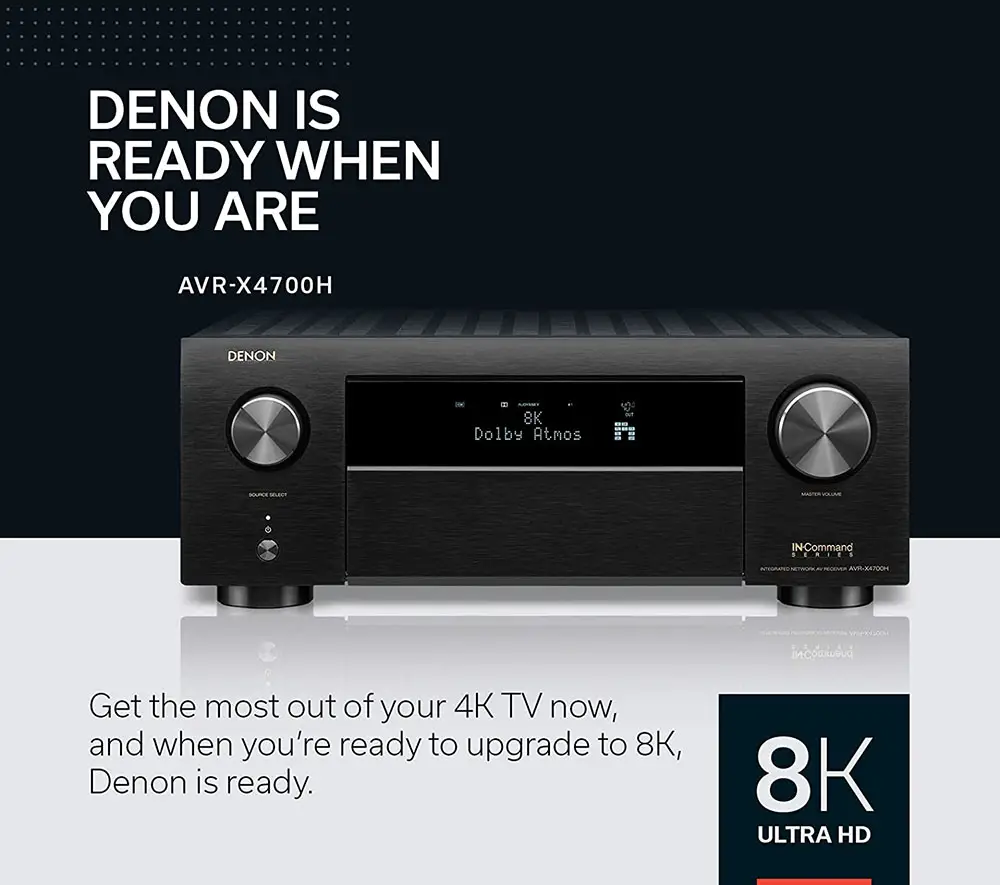
With such a receiver you cannot go wrong if you are an avid movie fan and adds so much to the overall experience that would feel flat and uninspiring otherwise.
High Resolution Audio has become the standard in these receivers so except from the usual low quality MP3, WMA and AAC the unit can also playback FLAC, ALAC and WAV files up to 192 kHz / 24-bit as well as DSD for both 2.8 and 5.6 MHz.
Pretty much the same as the X3700H here but with one small difference. The AVR-X4700H comes also with AL32 Processing. For those that don’t know what this is, Alpha processing was the world’s first technical formula for reproducing 16-bit data in 20-bit quality. The ALPHA processor interpolates the data recorded on the original CD so that the waveform is more natural. This will result in a more pure waveform that it is much closer to the CD digital signals without any processing.
Denon has further developed its proprietary AL32 Processing, an analog waveform reproduction technology, to support the 192 kHz sampling frequency. AL32 Processing, thoroughly suppresses quantization noise associated with D/A conversion to reproduce the low-level signals with optimum clarity that will bring out all the delicate nuances of the music.
Last part of our tests is music so we switched to a 2 channels setup and got some tunes to see what the X4700H can do with something more delicate. For this we used the front USB to playback some favorite songs in FLAC format for the best quality possible.

The Denon was very good with the tinniest of details and obviously if you pair it with some good quality speakers it will show what it is capable of. Each music instrument felt distinct, there was very good transparency at the front while panning stereo effects were rendered faithfully. The mid-range didn’t show any abnormal behavior with the unit keeping everything under control while the high end had the energy and vigor required without becoming too excessive.
As with the X3700H we tried various genres and we were very happy with how the AV receiver decided to handle each song. More delicate when it needed to be, more aggressive in others but what characterized the whole session was the integrity the Denon showcased the whole time. It never overdid itself or let it loose control keeping all elements at bay and to the best of its abilities. Vocals had the necessary emotional impact without tiring you while the bass would dig deep with authority and power without feeling boomy or distorting at any point.
Closing this part what we can say is that the AVR-X4700H will give you the typical Denon performance that we have come to expect the last few years. Denon knows its craft and the X4700H continues this tradition making this unit an excellent candidate if you are looking for an all around solution that can be equally good in movies and music. Is it perfect? Of course not, but trust us when we say that you are not going to be disappointed by it at all.
Ports and Connectivity
The arrival of HDMI 2.1 in 2020 marked a very big step forward compared to previous years but not without problems. We will talk about the HDMI 2.1 bug shortly but another thing we noticed is that many of the lower or mid-tier releases, like the AVR-X3700H or AVR-X2700H, miss the front HDMI port we found extremely useful in the previous years.
Fortunately the X4700H manages to keep the front port which can be such a practical addition. The rest of the front ports include the Headphones jack, the setup microphone port and the USB port all covered under the flip-door which is definitely a plus as it keeps them clean of dust.
At the back the first thing we noticed are the 11 speaker terminals that are placed in a straight line at the bottom which helps a lot with cable management. The terminals are the usual quality we have seen from Denon so all is good here with good quality plastic caps but if you want to use the full 11 channels you will need an external amplifier for the last two channels.
At the top we find, per usual, the second most important connections with 7 HDMI inputs and 3 HDMI outputs. Here the only change we find compared to its predecessor is that the 7th input has been switched to the new HDMI 2.1. Unfortunately we get only one new port so basically we see the same ports design as we saw in the 2020 Marantz releases but as Sound United owns both brands this shouldn’t come as a surprise.
As for everything else we get 3 component video inputs and 1 output, 3 composite video inputs and 2 outputs, 1 Ethernet port, 2 coaxial and 2 optical digital audio inputs, 11.2 channels pre-outs, zone 2 and zone 3 outputs, 5 analogue audio inputs and one more dedicated for phono, a remote control input and one more output, an RS-232C port for control, 2 12 volts trigger outputs and the usual FM/AM antenna inputs along with the WiFi/Bluetooth connectors.

In case you were wondering the differences here between the X3700H and the X4700H are that the unit we have here has an extra HDMI input (front), a second 12 volts trigger, zone 3 support and a second composite video output. And that’s all.
As for the new HDMI 2.1 this supports all the old along with a few new exciting technologies including 8K/60Hz and 4K/120Hz video pass-through, 4:4:4 Pure Color sub sampling, HDR10, Dolby Vision, Hybrid Log-Gamma (HLG), Dynamic HDR, 3D, BT.2020 pass-through, ALLM, VRR, QMS, QFT, ARC, eARC, Auto LipSync and HDMI-CEC.
Something we do note in all our recent AV receivers reviews is the HDMI 2.1 problems that plague all 2020 AV receivers that support HDMI 2.1. We have already mentioned this problem in our pevious Denon and Marantz reviews so we will just repeat here what we mentioned in our previous articles.
It seems that the Panasonic chip that Sound United got for their 2020 models and handles the HDMI 2.1 connection cannot process the signal of specific sources that output at 4K/120Hz RGB signal (8-bit, 10-bit, 12-bit) like the Xbox Series X and this results in a black screen. Now there are not many sources that currently support 4K@120Hz with this exact configuration but unfortunately this is a hardware limitation and cannot be solved by a simple firmware update.
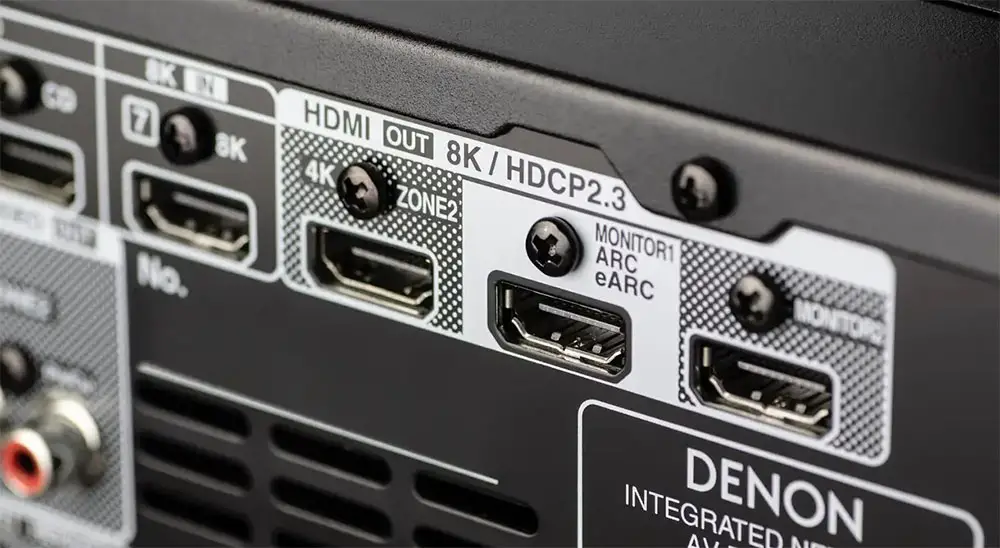
Now if you are wondering, the X4700H has no problem whatsoever if you are watching movies or playing games at 4K/60Hz and 4K/120Hz YCbCr 4:2:2 signals (32Gbps) or anything below that so in most cases you are going to be absolutely fine. This means that the PS5 will work without any problems at all. In the rare case where the receiver accepts a 4K/120Hz RGB signal (8-bit, 10-bit, 12-bit), like from the Xbox Series X for example, this is when this problem will appear.
Right now this problem seems to affect all AV receivers in 2020 including Denon, Marantz and Yamaha. All manufacturers have acknowledged the problem and they have offered different solutions each. What Sound United has decided to do is offer, free of charge, an HDMI adapter called SPK618 that is handling the HDMI input signal and converts it in one that these receivers can handle. As such the X4700H, with the use of this adapter, can accept even signals from the Xbox Series X without any problems.
In case you are worried about this problem but you would like to get the X4700H you can head to Denon’s website and fill in the form to receive this adapter for free. We did have this adapter available and we can confirm that by connecting it to our X4700H it can now handle all signals even from Xbox and Nvidia cards that would result in a black screen previously.
Lastly the unit comes with the standard set of wireless capabilities. With it’s built-in WiFi it can connect both in 2.4GHz and 5 GHz networks while it also supports Bluetooth streaming. The X4700H supports Bluetooth 4.2 which is not as efficient as the newer v5 but as with the previous Denon AV receivers that also came with v4.2 we didn’t notice any connectivity problems at all during testing.

The X4700H has everything you would expect from this category of AV receivers. The HDMI 2.1 bug stinks but at least there is a solution now available without any extra cost which certainly returns some of the value these AV receivers had lost due to this problem.
OS, Apps and Features
The latest releases are so fully packed with features that it’s almost impossible to add anything new that is worthwhile. So this part doesn’t seem to have major differences from what we found in the previous year’s releases. Also the AVR-X4700H seems to have a very similar feature set to the AVR-X3700H with only a couple of additions that we will mention shortly. As such this section of our review will be similar to our previous articles but as always we will make changes and additions wherever we deem necessary.
First of all we will talk about the audio calibration system. Denon is using the Audyssey system and as with all manufacturers they scale it accordingly to meet the price and performance standards of each of their models. For the X4700H we get the Audyssey MultEQ XT32 version which is their best and most feature complete suite. In comparison this one features the highest resolution filters which can result in higher accuracy during calibration.
The Audyssey MultEQ XT32 also comes with Dynamic Volume, Dynamic EQ, Audyssey LFC and Audyssey sub EQ HT. This version of Audyssey has the ability to analyze up to 8 different listening positions with the help of the included microphone and creates precise digital filters in order to offer the best audio result for your particular space.
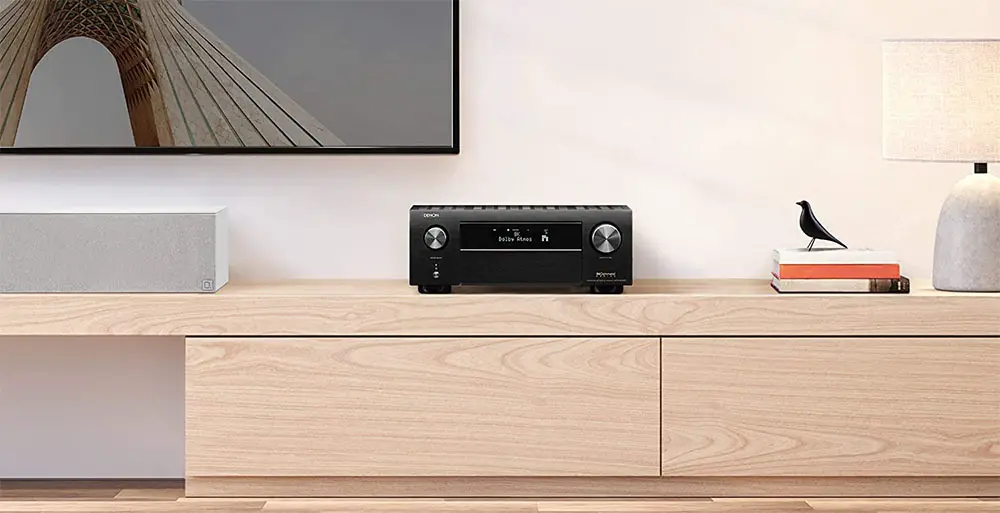
But except from the core system we also get Dynamic EQ which is a feature that is responsible for keeping the clarity and dynamic levels of audio even when you like to watch at low volume, like for night viewings for example. Dynamic Volume on the other hand is capable of balancing sudden changes and spikes in volume that could appear when there are sudden changes from TV broadcasting to commercials.
There is also Audyssey LFC that uses advanced psychoacoustic algorithms to deliver more full-range balance, including deep bass, without disturbing neighbors or people in other rooms of your home and lastly Audyssey Sub EQ HT that provides individual DSP tailoring of each subwoofer in a dual subwoofer setup for deeper bass with improved definition.
Going through the Audyssey calibration can be done either through the built-in wizard or if you want to dive deeper into calibrating your system then you can download the Audyssey MultEQ Editor app that is available for Android or iOS and do a more thorough setup with the help of your mobile device. Only keep in mind that this app has a one time fee which is a shame to be honest when you already pay such a high price for the receiver. As for the built-in system this is more than enough for most casual users as it offers almost everything you need to make very good and precise adjustments to your system.
But Denon provides another app for this AV receiver and this one comes completely free. The Denon 2016 AVR Remote app as it is called lets you control the unit with your mobile device through a nice visual interface. If you are tired of the included remote this is a nice and most important free alternative. The app is available for both Android and iOS devices so we suggest you give it a try to see if you like it.
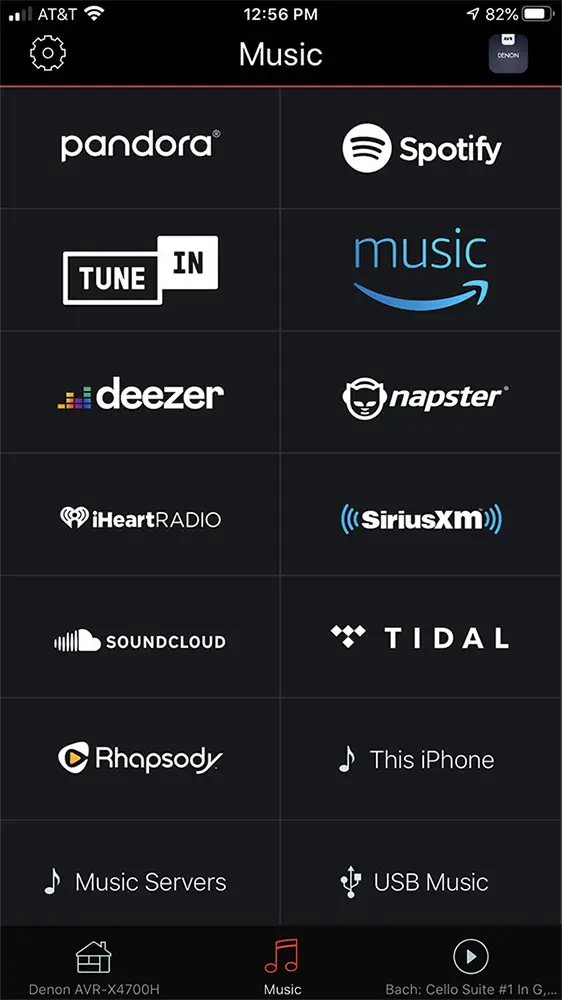
As for the menus there is nothing different here as we still get the simple graphics menu we have for some years now from both Denon and Marantz. It is functional and gets the job done but when compared to the UI of modern TVs it feels like AV receivers are years behind. Obviously these UIs are not meant to be used all the time like we do in TVs but still something that will look more fresh and more 2021-ish shouldn’t be too hard to make.
The receiver comes with the usual streaming as well as multi-zone capabilities that Denon includes in almost all their units. As it supports both HEOS and Airplay 2 you can either stream music online from one of the available online streaming services that include TuneIn Internet Radio, Spotify, Pandora, Amazon Music HD, TIDAL, SiriusXM and Deezer among others or create your own multi-room environment with the use of appropriate wireless speakers that support either HEOS or Airplay 2. Both the HEOS and Airplay 2 apps are available for downloading from their appropriate stores for use with your mobile device.
But if you prefer a wired connection the X4700H also supports Zone 2 and Zone 3 and here we find another difference from the AVR-X3700H which had only Zone 2 support.
Online is only one way to stream audio these days and modern AV receivers gives you a lot of freedom in the way you listen to music. One way is to stream audio from a network drive or NAS server if it happens you to have one connected to your local network. Also with the included USB port you can stream music through some connected external storage or flash drive. Lastly if you prefer a more wireless way of streaming your music there is Bluetooth available for connecting with your mobile device. If you use Apple devices then Airplay 2 can also be used to stream music wireless through it.

And since we mentioned Bluetooth there is a new addition in the X4700H as far as audio output as it seems that the receiver can output audio in two different ways using its Bluetooth transmitter. The X4700H is capable at streaming audio to Bluetooth enabled headphones for a completely silent house experience or it can also output sound from both its speaker terminals and to a Bluetooth headset. This can be particularly practical in case there is a member in the family that is hearing impaired. This is a feature that many of Denon and Marantz models have in 2020 and surely can be a handy one for certain situations.
Denon is known for including all known voice control platforms to most of their models and the X4700H is not any different in this regard. As such there is support for both most known ones with Amazon Alexa and Google Assistant but there is also support for Apple’s Siri through the Airplay 2 app and the advanced automation system Josh.ai making this receiver feature complete in this regard.
Another handy feature that we do find is HDMI-CEC and this one lets you use the TV remote to control the AV receiver if the TV also supports this. You can understand the practicality of this as this way you can reduce the amount of remotes you will need to have in your home theater. Obviously this feature lets you use only the most basic functions of the receiver but for everyday use it can be a very time saving one. This is an old feature that we see being included for the last few years now.
But there are many more features included in the X4700H so we will try to name as many of them as we can. The receiver supports video upscaling to 8K resolution both from its HDMI inputs and from its analog inputs which is another difference to the AVR-X3700H. Although upscaling from analog inputs has certain limitations in terms of resolutions accepted for upscaling and also in what resolution the upscaled image can output from the HDMI port. The manual has a very detailed table which can show you all information if you are particularly interested in this.
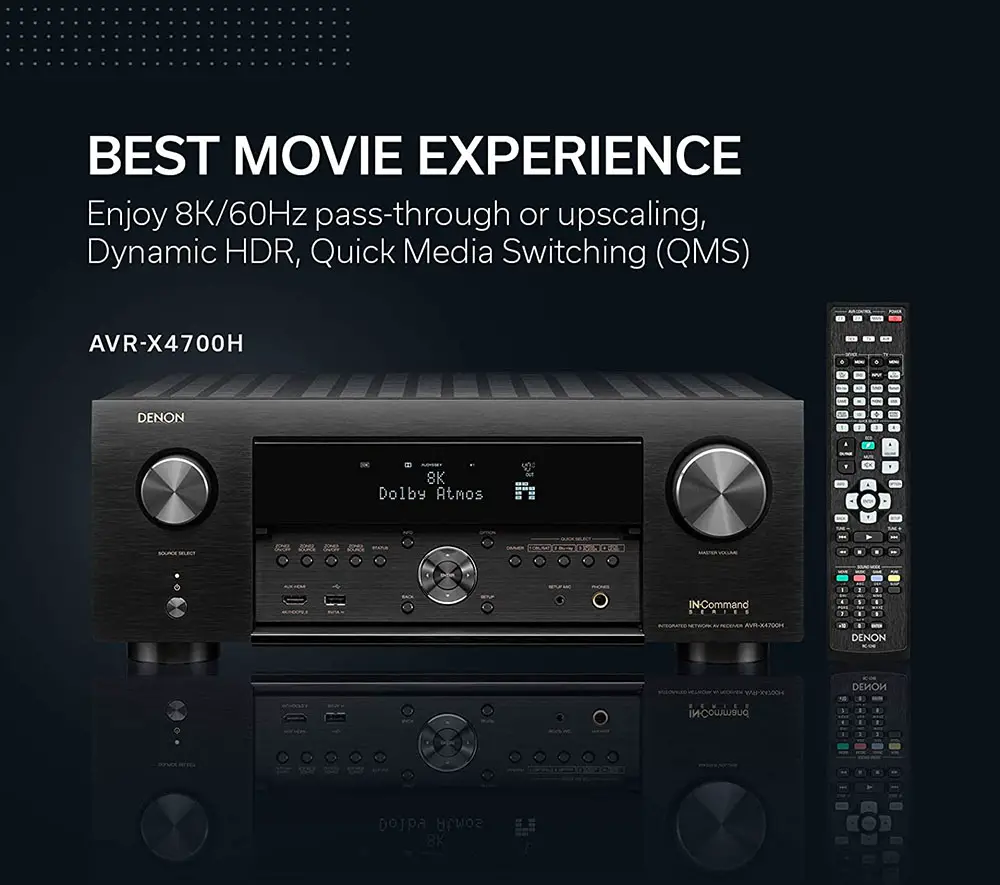
We also get bi-amp capabilities which is a favorite among home theater fans, an ECO mode that can regulate the receiver’s power usage for a more environmental friendly power consumption, custom integration for Domotz Pro, OvrC and Control4 SDPP as well as being “Roon Tested” certified.
For this last one there seems to be a bit of confusion as there are two types of certifications so let’s try to make things a bit more clear. The two certifications are Roon Ready and Roon Tested. The X4700H, as with most receivers from Denon and Marantz, is Roon Tested which means while Roon will work on this unit you will not get the highest quality possible. So for example if you use Airplay, audio quality is limited to 16 Bit/44.1kHz. If Roon functionality is specifically important to you and you also want your files to be streamed in their original quality then you will most certainly have to find a unit that bears the Roon Ready certification.
Except from the Bluetooth Audio Transmission the other most noteworthy addition this year is the Pre-Amplifier Mode with which your Denon AV receiver works as a perfect AV pre-processor with the latest HDMI connectivity. Pre-Amplifier Mode provides a cleaner signal path and more tolerance in clipping level by disconnecting internal amplifiers.
We have seen this feature in many of 2020 Marantz and Denon AV receivers and while it may have its uses we don’t see this being widely used as most that go the separates way will prefer to buy a processor plus amplifier for that job. The main strength of an AV receiver is that it combines everything in one package so this feature slightly nullifies this advantage it has.
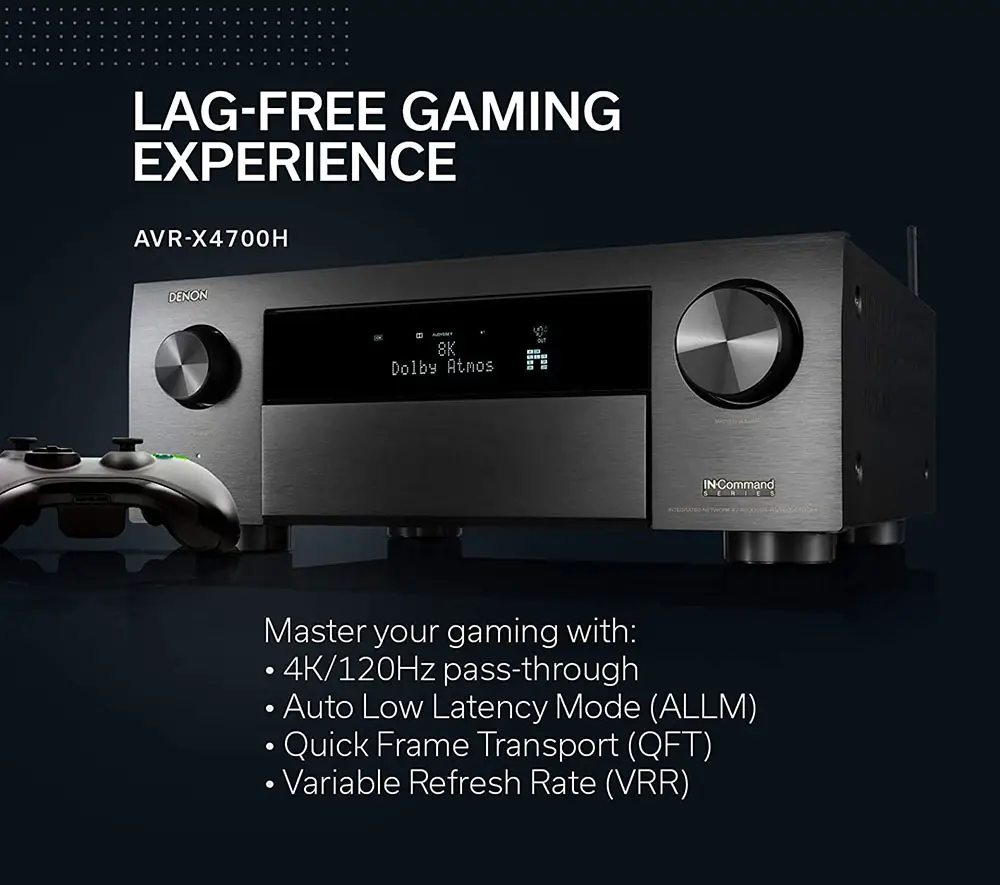
Final Thoughts
The AVR-X4700H is the second 9.2 channels AV receiver in Denon’s arsenal and to be honest it finds itself in a tough spot not because it is not good but because surprisingly it faces very high internal competition from its smaller brother, the AVR-X3700H. More than a few times I have seen people asking which one of the two to go for and if the extra cost of the X4700H is worth it.
First of all in order to determine if it is worth it you need to know what more it offers and while we did mention everything in our review let’s put them all here for a more easy comparison. For the extra cost the X4700H will give you Auro-3D and AL32 processing along with 20 watts more power to each channel. You also get an extra HDMI port (at the front), another 12 volts trigger port, one more composite video output while in terms of extras there is also analog to HDMI upscaling and Zone 3 support.
All the above come in addition to what is already there in the X3700H including 9.2 channels of built-in amplification with 11.2 channels processing, HDMI 2.1 support with all its new game centric features and a wealth of online and streaming functions making the X4700H one of the most feature complete units of its category. In terms of audio quality you will get what you should expect from a Denon product and we were completely satisfied by how it performed both in our movies testing and also in our music session.
As for the downsides as you guessed the HDMI 2.1 bug comes in mind and is a problem that will plague all 2020 AV receivers. At least Sound United solution with the SPK618 HDMI adapter makes things a bit better in terms of a solution to the problem. Also having a single HDMI 2.1 may be a problem from those with multiple next generation gaming consoles. We would also like to see the Audyssey MultEQ Editor app being offered for free, at least for the more expensive models and lastly a backlit remote should be a given for such high profile units and it’s unacceptable that Denon is still not making one.
The Denon AVR-X4700H is a very capable AV receiver and offers lots of value with its fully packed features set. Having mentioned all the extras you get for the additional cost compared to the X3700H you can determine by yourself it it is worth it or not and to be honest it really depends if these extras are important for your particular situation or not because in terms of actual audio performance the unit is more than capable at delivering an amazing surround experience that is very characteristic of most Denon products.

For more reviews you can check our dedicated 9 channels 8K AV Receiver reviews list or even look at our Product Reviews Table where you can find the brand and specific product you are looking for.
Cheapest Places to Buy :
*We are a reader-supported website. When you buy through links on our site, we may earn a small affiliate commission at no extra cost to you. Home Media Entertainment does not accept money for reviews.*
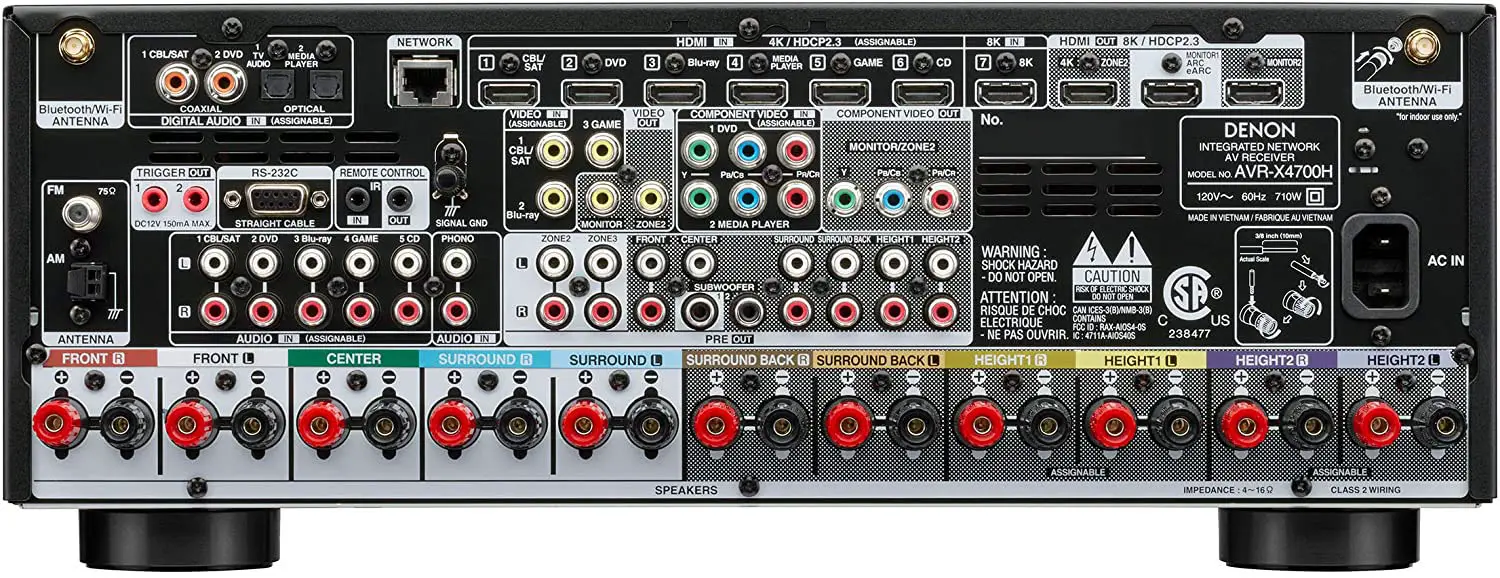
Hi there,
I must say, Denon, is a market leader for me when it comes to surround sound systems.
The X4700H is a beast. I have the X3300W and the sound quality was incomparable. You are really tempting me with this review right now.
I will certainly keep some money aside for an upgrade when it is due. I love this machine.
Denon may not be the best quality money can buy but they haven’t made a name by luck. Their receivers have good value and they manage to keep their standards year after year making them one of the top mainstream choices for the AV receivers market.
We recently bought a brand new big screen tv and we are in the market for a really good surround sound system. I had Denon in my scope but I was struggling to decide between the X3700H and the X4700H. Thanks for making their differences so clear and easy to distinguish.
You are welcome. If you need any further help with setting up your surround system let me know.
Hi, would the X4700H be powerful enough to comfortably drive Dynaudio Emit 50’s in a home theatre / music setup given the sensitivity & power needs of the Emits?
Hello Steve. Hard to say since I do not have personal experience with the Dynaudio (yet). I do see that they have some pretty hefty power requirements but I do not want to tell you something that I am not sure about. I can only give suggestions and recommendations when I am absolutely sure about something.